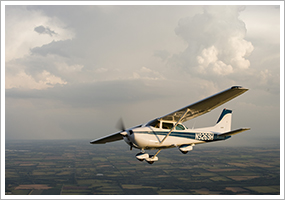Custom content from the Sept. 10, 2010, issue of 'AOPA ePilot' newsletter
| The following stories from the September 10, 2010, edition of AOPA ePilot were provided to AOPA members who expressed an interest in the particular subject areas. Any AOPA member can receive information tailored to their areas of interest by updating their preferences online. |
training tipsWind awareness aloft
Some clues are obvious. Look out the windscreen. Are cloud heights, sky coverage, and visibility as forecast? Have you updated your altimeter setting by monitoring ATIS broadcasts along your route and transmissions from air traffic control? On the ground at the destination, compare your altimeter’s indication to the published field elevation as described in the July 30 “Training Tip: Field elevation.”
What about wind changes en route? Smokestacks, trees, and bodies of water may offer information on changes in surface wind speed and direction until the airport windsock comes into view. Groundspeed and the heading required to hold course can alert you to changed winds aloft. The arrival of fronts may be earlier or later than forecast, but fortunately the change is usually heralded by a noticeable wind shift. “Seeing the windsock change direction is one of the most obvious signs of frontal passage. To determine frontal passage in the air, watch for a change in your wind correction angle and look for changes in the outside air temperature (OAT). Also, note any differences in altimeter settings reported by ATC or on ASOS/AWOS and ATIS broadcasts,” explains the AOPA Air Safety Foundation’s WeatherWise Safety Advisor. Some weather changes typical to the local area around an airport are predictable. In the December 2006 Flight Training “The Weather Never Sleeps” column, meteorologist Jack Williams described how the appearance of cumulus congestus clouds reveals changes at one Florida airport: “These cumulus congestus clouds mark the ‘sea breeze front’ a few miles inland from the sand dunes at Neptune Beach in northeastern Florida. The sea breeze is created as air from over the relatively cool ocean flows inland to replace air rising over the much hotter land in the afternoon.” You can follow the best guidance and still run into surprises. (See the July 23 “Training Tip: Gone with the wind” on why that should not leave you discouraged.) But by keeping your eyes and ears open, you will reduce such occurrences to a minimum, while developing valuable pilot intuition about evaluating the flight conditions ahead. training productsASA releases Private Pilot Checkride appGot a checkride or flight review in your future? ASA’s Private Pilot Checkride app is available for the iPhone, iPad, and iPod Touch. The app is based on the Private Oral Exam Guide book and includes nearly 500 questions and responses. Topics include certificates and documents, weather, determining performance and limitations, airplane systems, cross-country flight planning, night operations, and aeromedical factors. Also included are an applicant practical test checklist and quick-reference table to the private pilot maneuvers and tolerances defined in the Practical Test Standards. The app costs $9.99 and can be downloaded from the iTunes store.
Note: Products listed have not been evaluated by ePilot editors unless otherwise noted. AOPA assumes no responsibility for products or services listed or for claims or actions by manufacturers or vendors. final exam
Question: I’m a student pilot and I’m just about to begin my cross-county flights for my private pilot certificate. Are there specific regulations regarding the fuel requirements for my flights?
Answer: Yes, there are fuel requirements, and in your specific case, since you are working on your private pilot certificate, you would be required to comply with 14 CFR 91.151, “Fuel requirements for flight in VFR conditions.” This regulation states: “No person may begin a flight in an airplane under VFR conditions unless (considering wind and forecast weather conditions) there is enough fuel to fly to the first point of intended landing and, assuming normal cruising speed—(1) During the day, to fly after that for at least 30 minutes; or (2) At night, to fly after that for at least 45 minutes.” For more information on fuel and fuel management, you may be interested in reading the AOPA Air Safety Foundation's “Fuel Awareness” Safety Advisor and this article from Flight Training.
Got a question for our technical services staff? E-mail [email protected] or call the Pilot Information Center, 800/872-2672. Don’t forget the online archive of “Final Exam” questions and answers, searchable by keyword or topic. |
 Some weather changes during a flight are predictable. When they appear, you’re ready. Other weather behavior can take you by surprise—unless you have acquired the skill of seeking out clues that the weather is straying from the forecast.
Some weather changes during a flight are predictable. When they appear, you’re ready. Other weather behavior can take you by surprise—unless you have acquired the skill of seeking out clues that the weather is straying from the forecast.

